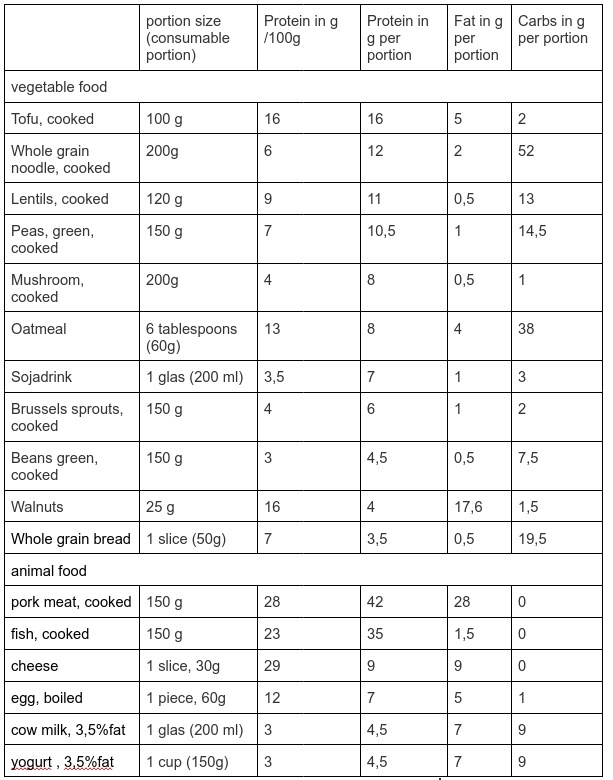Proteins can not only be delicious, they are also vital building blocks! Muscles, hair, blood, connective tissue, antibodies, enzymes and much more are formed in the body from amino acids, the smaller building blocks of proteins. Therefore, the human body consists of 7-13 kg of the building material protein, depending on age.(1) This article tells you interesting facts about the nutrient protein including the recommended amount we need, what foods provide protein, healthy protein choices, and how protein impacts blood sugar.
So first of all to the most important question: What influence (or impact) do proteins have on blood glucose levels?
Not only carbohydrates affect the glucose concentration in the body.
With low-carbohydrate meals or even meals that contain a large portion of protein, the liver comes into play. It forms new glucose from the components of fats and proteins. This process is called gluconeogenesis or new glucose formation and the conversion can take up to 8 hours. Thus, after a meal containing fat or protein, glucose levels may continue to rise for hours after the meal. (14)
For people with type 1 diabetes, therefore, it can be helpful to factor in extra insulin for these late surges, since the meal bolus they gave at mealtime won't work for that long.
If this topic is new to you, ask your diabetes team how to schedule fat-protein units into the insulin dose calculation.
In people with type 2 diabetes, protein-induced blood glucose increases are usually not as pronounced, as they often still have endogenous insulin to get the sugar from gluconeogenesis into the body's cells.
How much protein does a person need?
According to professional associations (European Food Safety Authority and Deutsche Gesellschaft für Ernährung), a daily intake of approx. 0.8 g protein per kg body weight is recommended for adults. For children, pregnant and lactating women, and people over 65 years of age, the daily protein needs are greater and the requirements range from 1-1.2 g per kg of body weight.(2,3,4)
A 75 kg (165 pounds) adult would therefore need about 60 g of protein per day. To determine your personal daily protein intake, you can multiply your weight in pounds by 0.36.
In cases of special diseases please check your daily protein intake with your HCP.
Do athletes need more protein?
For recreational athletes who, for example, exercise 4-5 times per week for 30 minutes, the usual recommended protein intake is sufficient.
For recreational athletes with at least 5 hours of training per week and especially for competitive athletes, the International Society of Sports Nutrition and the American College of Sports Medicine recommend a flexible amount of protein supply of approx. 1.2-2.0 g protein/kg body weight per day, depending on the type of sport and training goal, intensity, extent or competition phase. The proteins should be distributed throughout the day and consumed as part of meals and not as supplements such as protein shakes! (12)
Does protein help with weight loss?
All successful nutrition concepts have one thing in common. They have a relatively high proportion of protein and reduce either fat or carbohydrates, or even both.
The higher protein content is especially important for satiety. As mentioned above, we need about 50-70 g of protein daily, depending on our body size. This is roughly about 15% of our daily energy intake, and can be slightly more when aiming for weight loss. It is recommended to have a source of protein at every meal, especially at breakfast, in order to reach that protein requirement helping us to feel full and more satisfied throughout the day. On the other hand, with foods such as chips and chocolate, which contain little protein in relation to the calorie content, it is easy to consume more calories than needed. (6)
What foods are naturally rich in protein?
In addition to meat, fish, dairy products and eggs, protein-rich foods also include legumes, such as soy, lentils and peas, as well as nuts and seeds. Whole grains such as bread, quinoa and oats also contribute to the supply of protein.
So what is the difference between plant and animal proteins?
Before you start increasing your daily protein intake, it is important to understand the difference between plant and animal proteins.
"More protein" should not mean "eating more meat" !
Proteins stimulate the release of hormones that promote growth. However, in adulthood up to 65 years of age (after this age an increased protein intake is recommended), too much protein promotes the aging process and the development of diseases such as type 2 diabetes, hypertension and cancer, etc. (7)
But here is the good news: this harmful effect applies only to animal proteins. When eating plant-based proteins, the risk of mortality actually decreases. (8)
An analysis of 9 studies examining the relationship between plant-based diets and diabetes risk also showed this to be the case. The greater the proportion of plant foods and the less animal products consumed, the less frequently the study participants developed type 2 diabetes. Those who exclusively or almost exclusively consumed plant-based products had a 20 percent lower risk of developing type 2 diabetes than those whose diets very frequently included animal products. (9)
However, there is also evidence that some animal products, such as yogurt and fish, have a protective effect on the cardiovascular system, while plant-based foods, such as refined grains or sugary foods, may have more adverse health effects. (9)
One should always think of foods as nutrient packages. Proteins rarely come alone and are often accompanied by fats, carbohydrates, vitamins and minerals. It is important to look for an overall package with as little saturated fat and refined carbohydrates as possible.
How can the intake recommendations be achieved?
Below, we have included a table of common foods and their protein intake for reference.In addition to the sufficient intake, the bioavailability of proteins is also important.
Vegetable and animal proteins differ in the composition of their amino acids and thus in their bioavailability. This means that animal proteins usually contain all the amino acids that humans need.
Plant foods, on the other hand, often do not have the full spectrum of amino acids needed. However, this can be compensated by clever combinations with other plant or animal proteins, such as the combination of legumes with grains . Such combinations often occur in traditional dishes anyway, such as lentil vegetables with rice or pea stew with bread. (5)
Good combination partners to achieve high bioavailability would be for example:
- eggs combined with potatoes, soy, peas, wheat or milk.
- Milk combined with wheat
- Legumes/tofu combined with grains or potatoes
- Beans combined with corn (10)

What about the average protein supply?
Of course, the protein supply situation is not the same in all countries. In most industrialized countries, however, it can be assumed that the supply is sufficient.
In the USA and Germany, most people meet or even exceed their requirements. This is particularly true for men between the ages of 19 and 59. The Dietary Guidelines for Americans, 2020-2025 and the National Nutrition Survey II in Germany (NVS II, 2005-2006) show that men in this age group often exceed their protein recommendations, especially through meat, sausage, eggs and dairy products. Even athletes often consume more protein than they need without supplements because their calorie requirements are higher. More food often means increased protein intake. (11,4)
Links:
Proteincalculator for pounds: https://www.nal.usda.gov/legacy/fnic/dri-calculator/
Sources:
-
Deutsche Gesellschaft für Ernährung [Internet]. Bonn; 2017 Sep 21 [cited 2022 Aug 11]. Wie viel Protein brauchen wir? Available from: https://www.dge.de/presse/pm/wie-viel-protein-brauchen-wir/
-
Deutsche Gesellschaft für Ernährung [Internet]. Bonn: 2017 [cited 2022 Aug 11]. Referenzwerte Protein, Available from: https://www.dge.de/wissenschaft/referenzwerte/protein/
-
Dietary Reference Values for the EU [Internet]. Parma: 2019 [cited 2022 Aug 11]. DR Finder, Available from: https://multimedia.efsa.europa.eu/drvs/index.htm
-
USDA [Internet], Washington: 2020 [cited 2022 Aug 11] dietary Guidelines for Americans, Available from: https://www.dietaryguidelines.gov/sites/default/files/2021-03/Dietary_Guidelines_for_Americans-2020-2025.pdf
-
Deutsche Gesellschaft für Ernährung [Internet]. Bonn; 2021 [cited 2022 Aug 11]. Ausgewählte Fragen und Antworten zu Protein und unentbehrlichen Aminosäuren
Available from: https://www.dge.de/wissenschaft/faqs/protein/ -
Kast B., Der Ernährungskompass: 17. edition, München: 2018, p.86-88.
-
Levine ME, Suarez JA, Brandhorst S, Balasubramanian P, Cheng CW, Madia F, Fontana L, Mirisola MG, Guevara-Aguirre J, Wan J, Passarino G, Kennedy BK, Wei M, Cohen P, Crimmins EM, Longo VD. Low protein intake is associated with a major reduction in IGF-1, cancer, and overall mortality in the 65 and younger but not older population. Cell Metab. 2014 Mar 4;19(3):407-17. doi: 10.1016/j.cmet.2014.02.006. PMID: 24606898; PMCID: PMC3988204.
-
Song M, Fung TT, Hu FB, Willett WC, Longo VD, Chan AT, Giovannucci EL. Association of Animal and Plant Protein Intake With All-Cause and Cause-Specific Mortality. JAMA Intern Med. 2016 Oct 1;176(10):1453-1463. doi: 10.1001/jamainternmed.2016.4182. Erratum in: JAMA Intern Med. 2016 Nov 1;176(11):1728. PMID: 27479196; PMCID: PMC5048552.
-
Qian F, Liu G, Hu FB, Bhupathiraju SN, Sun Q. Association Between Plant-Based Dietary Patterns and Risk of Type 2 Diabetes: A Systematic Review and Meta-analysis. JAMA Intern Med. 2019 Oct 1;179(10):1335-1344. doi: 10.1001/jamainternmed.2019.2195. PMID: 31329220; PMCID: PMC6646993.
-
Wikipedia contributors [Internet] Biological value. Wikipedia, The Free Encyclopedia. [cited 2022 Aug 11]. Available at: https://en.wikipedia.org/w/index.php?title=Biological_value&oldid=1079742835.
-
Max Rubner-Institut Bundesforschungsinstitut für Ernährung und Lebensmittel [Internet]. Karlsruhe; 2008 [cited 2022 Aug 11]. Nationale Verzehrsstudie Deutschland. Available from: https://www.bmel.de/SharedDocs/Downloads/DE/_Ernaehrung/NVS_ErgebnisberichtTeil2.pdf?__blob=publicationFile&v=2
-
König D, Carlsohn A, Braun H, Großhauser M, Lampen A, Mosler S, Nieß A, Schäbethal K, Schek A, Virmani K, Ziegenhagen R, Heseker H: Proteins in sports nutrition. Position of the working group sports nutrition of the German Nutrition Society (DGE). Ernahrungs Umschau 2020; 67(7): 132–9.
-
Bell KJ, Smart CE, Steil GM, Brand-Miller JC, King B, Wolpert HA. Impact of fat, protein, and glycemic index on postprandial glucose control in type 1 diabetes: implications for intensive diabetes management in the continuous glucose monitoring era. Diabetes Care. 2015 Jun;38(6):1008-15. doi: 10.2337/dc15-0100. PMID: 25998293.
The mySugr website does not provide medical or legal advice. mySugr blog articles are not scientific articles, but intended for informational purposes only.
Medical or nutritional information on the mySugr website is not intended to replace professional medical advice, diagnosis or treatment. Always consult a physician or health care provider with any questions you may have regarding a medical condition.





